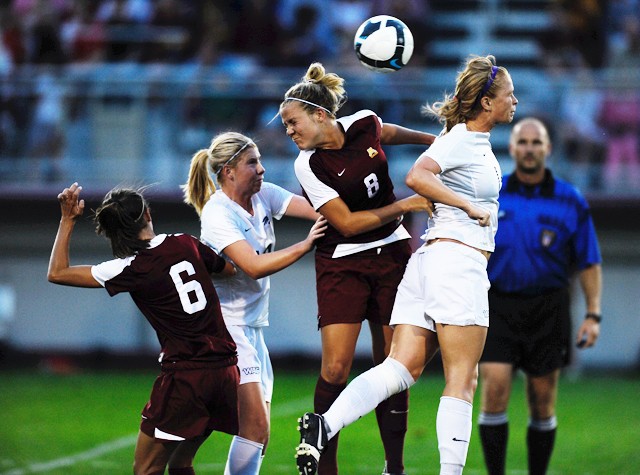A comprehensive study of injuries among five fall college sports released by the NCAA last week found that concussions were the second most common injuries in football and soccer, behind ankle injuries. The study, which tracked injuries occurring between the 2004-05 season and the 2008-09 season, revealed that concussions comprised nearly 7 percent of all injuries in college football and 11 percent in womenâÄôs soccer. Prior to its public release, the data helped spur a January decision by the NCAA Playing Rules Oversight Panel instructing playing-rules committees to examine their existing policies and consider instituting additional rules to prevent head injuries. In February, the NCAA Football Rules Committee became the first to act when it announced a rule change aimed at promoting player safety. The rule states that players who leave the game as a result of injury must be examined and cleared by medical staff before returning to the game. The rule is crafted to explicitly cover players who exhibit signs of concussions. Northwood University Athletics Director and Football Rules Committee member Pat Riepma calls the rule change âÄúan important step forwardâÄù in college football. âÄúSafety is our No. 1 concern, and weâÄôre going to do everything we can as a rules committee to make sure our student-athletes are in a safe environment,âÄù Riepma said. Perhaps more than in any other sport, a culture of playing when hurt has been cultivated in football. Riepma said that the old adage of âÄúplaying through the painâÄù is obsolete, especially when it comes to head injuries. The rule change takes the decision of whether a player should return to the field after an injury away from players and coaches, Riepma said. âÄúIt puts the decision in the hands of the medical people, and thatâÄôs where it belongs,âÄù Riepma said. University of Minnesota head football trainer Ed Lochrie said the team has physicians on the sideline who can evaluate players with suspected head injuries. Lochrie said the medical staff checks players for concussion symptoms, which include headaches, nausea, sensitivity to light and loss of balance. In most cases, players with concussions are unable to feign their way through the sideline tests they are given, Lochrie said. âÄúYou canâÄôt fake not having any ability to balance,âÄù he said. The medical staff also performs memory recall tests and occasionally asks players to count backward or recite the months of the year, Lochrie said. Though concussion injuries have received a lot of attention in football, the recent study conducted by the Datalys Center indicates that they are prominent in other sports as well. Between 1988 and 2004, concussion rates among all sports rose by 7 percent each year. Days after the Football Rules Committee took action, the MenâÄôs and WomenâÄôs Soccer Rules Committee followed suit. One aspect of the soccer rule change grants referees the authority to stop play if a player is exhibiting signs of concussions. C. Cliff McGrath, the secretary-editor of the soccer rules committee and former coach at Seattle Pacific University, said the increased awareness of head injuries as well as liability issues factored into the decision. âÄúWeâÄôre in an era where that old business of picking up your broken leg and running down the field one-legged is past, and we want to be very aggressive in how we approach this issue,âÄù McGrath said. The rule also stipulates that teams who remove players from games after showing signs of concussion would not be charged with a substitution, and the player may return if cleared by medical personnel. Northwestern UniversityâÄôs menâÄôs soccer coach Tim Lenahan, who sits on the soccer rules committee, said his only minor concern with the rule change is that some coaches might manipulate the rule in order to rest players, but he added that player safety is the primary concern. âÄúThere was never discussion whether it was the right thing to do or not,âÄù Lenahan said. Possible long-term effects of concussions can include increased risk of clinical depression, long-term memory loss and an increased risk of developing AlzheimerâÄôs disease and a similar condition known as dementia pugilistica.











